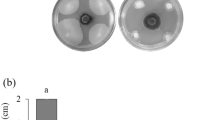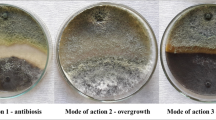Abstract
Brassica nigra (black mustard) and B. juncea (Indian mustard) genotypes were tested for pathogen suppression and release of allyl isothiocyanate (AITC), a fungitoxic volatile produced in mustard tissue after enzymatic hydrolysis of allyl glucosinolate (sinigrin). In bioassays, 28 genotypes of B. nigra and 35 genotypes of B. juncea were screened for inhibition of the potato pathogens Helminthosporium solani and Verticillium dahliae by volatiles released from macerated leaf tissue. Release of AITC from plant tissue was quantified by gas chromatography; isothiocyanate profiles were determined by headspace analysis. All mustard genotypes produced compounds that suppressed radial growth of both fungi. Growth suppression and AITC release differed significantly (P < 0.001) among genotypes of B. nigra and B. juncea. Mustard treatments releasing >1.2 mg AITC/g plant tissue were fungicidal to both pathogens. Headspace analysis confirmed that allyl glucosinolate was the major glucosinolate in all genotypes of B. nigra tested; most genotypes also produced 2-phenylethyl-isothiocyanate (ITC). Brassica juncea genotypes produced variable amounts of AITC and other volatiles with antimicrobial activity, including 2-phenylethyl-ITC, benzyl-ITC, and 3-butenyl-ITC. Evaluating mustards from geographically diverse locations allowed selection of mustard genotypes that may be useful in breeding programs designed to develop disease-suppressing green manure cultivars.
Similar content being viewed by others
REFERENCES
Angus, J. F., Gardner, P. A., Kirkegaard, J. A., and Desmarchelier, J. M. 1994. Biofumigation: Isothiocyanates released from Brassica roots inhibit growth of the take-all fungus. Plant Soil 162:107–112.
Bialy, Z., Oleszek, W., Lewis, J., and Fenwick, G. R. 1990. Allelopathic potential of glucosinolates (mustard oil glycosides) and their degradation products against wheat. Plant Soil 129:277–281.
Chin, H.-W., and Lindsay, R. C. 1993. Volatile sulfur compounds formed in disrupted tissues of different cabbage cultivars. J. Food Sci. 58:835–841.
Cole, R. A. 1976. Isothiocyanates, nitriles and thiocyanates as products of autolysis of glucosinolates in Cruciferae. Phytochemistry 15:759.
Daxenbichler, M. E., Spencer, G. F., Carlson, D. G., Rose, G. B., Brinker, A. M., and Powell, R. G. 1991. Glucosinolate composition of seeds from 297 species of wild plants. Phytochemistry 30:2623–2638.
Delaquis, P. J., and Sholberg, P. L. 1997. Antimicrobial activity of gaseous allyl isothiocyanate. J. Food Prot. 60:943–947.
Duncan, A. J. 1991. Glucosinolates, pp. 126–147, in J. P. F. D'mello, C. M. Duffus, and J. H. Duffus (eds.). Toxic Substances in Crop Plants. Royal Society of Chemistry, Cambridge, UK.
Ettlinger, M. G., and Kjaer, A. 1968. Sulfur compounds in plants. Recent Adv. Phytochem. 1:59–141.
Fenwick, G. R., and Heaney, R. K. 1983. Glucosinolates. CRC Crit. Rev. Food Sci. Nutr. 18:123–201.
Glover, J. R., Chapple, C. C. S., Rothwell, S., Tober, I., and Ellis, B. E. 1988. Allyl glucosinolate biosynthesis in Brassica carinata. Phytochemistry 27:1345–1348.
Hooker, W. J. 1981. Compendium of Potato Diseases. American Phytopathological Society, St. Paul, Minnesota.
Jellis, G. J., and Taylor, G. S. 1974. The relative importance of silver scurf and black dot: Two disfiguring diseases of potato tubers. ADAS Q. Rev. 14:97–112.
Kirkegaard, J. A., Gardner, P. A., Angus, J. F., and Koetz, E. 1994. Effect of Brassica break crops on the growth and yield of wheat. Aust. J. Agric. Res. 45:529–545.
Kirkegaard, J. A., Wong, P. T. W., and Desmarchelier, J. M. 1996. In vitro suppression of fungal root pathogens of cereals by Brassica tissues. Plant Pathol. 45:593–603.
Kjaer, A. 1973. The natural distribution of glucosinolates: a uniform group of sulfur-containing glucosides. Chem. Bot. Class. Nobel 25:229–234.
Koritsas, V. M., Lewis, J. A., and Fenwick, G. R. 1991. Glucosinolate responses of oilseed rape mustard and kale to mechanical wounding and infestation by cabbage stem flea beetle (Psylliodes chrysocephala). Ann. Appl. Biol. 118:209–222.
Kuehl, R. O. 1994. Statistical Principles of Research Design and Analysis. Duxbury Press, Belmont, California.
Lazzeri, L., Tacconi, R., and Palmieri, S. 1993. In vitro activity of some glucosinolates and their reaction products toward a population of the nematode Heterodera schachtii. J. Agric. Food Chem. 41:825–829.
Lewis, J. A., and Papavizas, G. C. 1971. Effect of sulfur-containing volatile compounds and vapors from cabbage decomposition on Aphanomyces euteiches. Phytopathology 61:208–214.
MacLeod, A. D. 1976. Volatile flavor compounds of the Cruciferae, pp. 307–330, in J. G. Vaughan, A. D. MacLeod, and B. M. G. Jones (eds.). The Biology and Chemistry of the Cruciferae. Academic Press, New York.
Mari, M., Iori, R., Leoni, O., and Marchi, A. 1993. In vitro activity of glucosinolate-derived isothiocyanates against postharvest fruit pathogens. Ann. Appl. Biol. 123:155–164.
Mayton, H. S., Olivier, C., Vaughn, S. F., and Loria, R. 1996. Correlation of fungicidal activity of Brassica species with allyl isothiocyanate production in macerated leaf tissue. Phytopathology 86:267–271.
Merida, C. L., and Loria, R. 1994. Survival of Helminthosporium solani in soil and in vitro colonization of senescent plant tissue. Am. Potato J. 71:591–598.
Mojtahedi, H., Santo, G. S., Hang, A. N., and Wilson, J. H. 1993. Managing Meloidogyne chitwoodi on potato with rapeseed as green manure. Plant Dis. 77:42–46.
Muehlchen, A. M. 1990. Evaluation of crucifer green manures for controlling Aphanomyces root rot of peas. Plant Dis. 74:651–654.
Neter, J., Wasserman, W., and Kutner, M. H. 1990. Applied Linear Statistical Models. Irwin, Homewood, Illinois.
Papavizas, G. C. 1966. Suppression of Aphanomyces root rot of peas by cruciferous soil amendments. Phytopathology 56:1071–1075.
Ramirez-Villapudua, J., and Munnecke, D. E. 1988. Effect of solar heating and soil amendments of cruciferous residues on Fusarium oxysporum f. sp. conglutinans and other organisms. Phytopathology 78:289–295.
Ristaino, J. B., and Thomas, W. 1997. Agriculture, methyl bromide, and the ozone hole: Can we fill the gaps? Plant Dis. 81:965–977.
Sang, J. P., Minchington, I. R., Johnstone, P. K., and Truscott, R. J. W. 1984. Glucosinolate profiles in the seed, root and leaf tissue of cabbage, mustard, rapeseed, radish and swede. Can. J. Plant Sci. 64:77–93.
Spak, J. 1988. The effect of glucosinolate sinigrin and of allyl isothiocyanate on the infectivity of turnip mosaic virus. Biol. Plant. 30:465–470.
Spencer, G. F., and Daxenbichler, M. E. 1980. Gas chromatography-mass spectroscopy of nitriles, isothiocyanates and oxazolidinethiones derived from cruciferous glucosinolates. J. Sci. Food. Agric. 31:359–367.
Subbarao, K. V., and Hubbard, J. C. 1996. Interactive effects of broccoli residue and temperature on Verticillium dahliae microsclerotia in soil and on wilt in cauliflower. Phytopathology 86:1303–1310.
VanEtten, C. H., and Tookey, H. L. 1983. Glucosinolates, pp. 15–30, in M. Rechcigl (ed.). Naturally Occurring Food Toxicants. CRC Press, Boca Raton, Florida.
Vaughn, S. F., and Boydston, R. A. 1997. Volatile allelochemicals released by crucifer green manures. J. Chem. Ecol. 23:2107–2116.
Williams-Woodward, J. L., Pfleger, F. L., Fritz, V. A., and Allmaras, R. R. 1997. Green manures of oat, rape and sweet corn for reducing common root rot in pea (Pisum sativum) caused by Aphanomyces euteiches. Plant Soil 188:43–48.
Woods, D. L., Capcara, J. J., and Downey, R. K. 1991. The potential of mustard [Brassica juncea (L.) Coss.] as an edible crop on the Canadian Prairies. Can. J. Plant Sci. 71:195–198.
Author information
Authors and Affiliations
Rights and permissions
About this article
Cite this article
Olivier, C., Vaughn, S.F., Mizubuti, E.S.G. et al. Variation in Allyl Isothiocyanate Production Within Brassica Species and Correlation with Fungicidal Activity. J Chem Ecol 25, 2687–2701 (1999). https://doi.org/10.1023/A:1020895306588
Issue Date:
DOI: https://doi.org/10.1023/A:1020895306588




